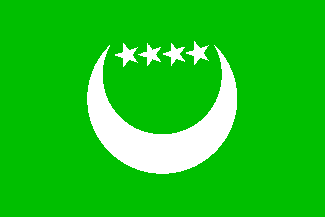
Last modified: 2019-01-11 by rob raeside
Keywords: crescent: points up (white) | variation | stars: 4 | stars: line | star: 5 points (white) |
Links: FOTW homepage |
search |
disclaimer and copyright |
write us |
mirrors
 image by Graham Bartram, 22 Jul 1996
See also:
image by Graham Bartram, 22 Jul 1996
See also:
Comoros - national index
In 1989, Bob Denard came back to the Comoros under his real name, Gilbert Bourgeaud, and murdered Abdallah on 27 November 1989. In spite of repeated attempts of coup, Said Mohammed Dzohar remained in power and a new Constitution was approved on 07 June 1992. A new flag, based on the design of the one used since 1978 was adopted with the following specifications (Calvarin [clv02]):
According to an article in The Flag Bulletin (No. 174)
[tfb]
in 1992 yet another variant saw the crescent and
stars now facing upwards.
Stuart Notholt, 22 May 1997
The stars point upwards and the crescent horns curving
more than 180 degrees, partially enclosing the four stars.
Graham Bartram, 22 Jul 1996
 image by Željko Heimer 25 Nov 1995
image by Željko Heimer 25 Nov 1995
A variant with four stars in a semicircular
half-moon, with tipped stars, also appears to have been used, as illustrated
above.
Željko Heimer 25 Nov 1995
I suspect the difference is more based on local
variants. I have copies of the relevant constitutions
and I don’t recall any of them being particularly
explicit on the details of the flags.
Iain Walker, 10 Feb 1999
The Flag Bulletin suggests that the
green in the 1975 and
1992 flags may have
been lighter than in the others. Neither this change
of colour, nor the positioning/orientation of the
crescent and stars, appear to have any broader significance. The changing of flags is,
in short, due to political volatility in the country.
Stuart Notholt, 22 May 1997